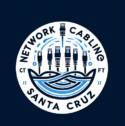Are LAN Cables Waterproof? Understanding Outdoor and Waterproof Ethernet Cables
If you’ve ever wondered whether LAN cables are waterproof, you’re not alone. Many homeowners and business owners need to run Ethernet cables outdoors or through damp areas and want to ensure they’ll hold up against the elements. The short answer is — most standard LAN cables are not waterproof, but there are specific waterproof Ethernet cables designed to withstand rain, moisture, and extreme weather conditions.
Let’s break down what that means, how to identify waterproof LAN cables, and when you should use them. Our team of structured cabling professionals in Santa Cruz ensures that every installation meets safety standards and performs reliably — even in challenging environments.
What Is a LAN Cable?
A LAN cable, also known as an Ethernet cable, connects devices like computers, routers, and switches within a Local Area Network (LAN). These cables transmit data at high speeds and are commonly labeled as Cat5e, Cat6, or Cat6a, depending on their performance level and data capacity.
While standard LAN cables work perfectly indoors, they aren’t built to handle outdoor environments where they’re exposed to sunlight, water, or fluctuating temperatures.
Are Regular LAN Cables Waterproof?
In most cases, no — standard LAN cables are not waterproof. Regular Cat5e or Cat6 cables are made with PVC jackets that offer minimal protection against moisture. Over time, exposure to rain or humidity can cause corrosion, signal interference, and even total connection failure.
If you’re running cables outside or through walls, basements, or garages where moisture is present, you’ll need to use outdoor-rated or waterproof Ethernet cables for reliable performance.
What Makes a LAN Cable Waterproof?
Waterproof LAN cables are designed with specialized materials and construction to prevent water damage. Here are the main features that make them weather-resistant:
- UV-resistant jacket: Protects the cable from sun damage and cracking.
- Gel-filled core: Keeps moisture from entering and damaging the copper wires.
- Shielded (STP) design: Reduces electromagnetic interference and protects the signal.
- PE (Polyethylene) outer jacket: More durable and waterproof than standard PVC.
These cables can be safely buried underground or run along exterior walls, making them ideal for outdoor cameras, Wi-Fi access points, and security systems.
When Should You Use Waterproof Ethernet Cables?
Waterproof LAN cables are ideal for situations where cables might be exposed to rain, humidity, or direct sunlight. Here are common scenarios:
- Outdoor security cameras (CCTV) – Ensures reliable connectivity in any weather.
- Garden offices or detached buildings – Connects separate structures to your main network.
- Outdoor Wi-Fi access points – Extends coverage without worrying about weather damage.
- Warehouses or industrial sites – Withstands temperature changes and moisture.
- Underground or conduit installations – Gel-filled and direct-burial cables prevent corrosion.
If your installation is completely exposed to the elements, it’s best to choose direct-burial Cat6 cables designed for permanent outdoor use. Understanding cable insulation and wiring helps determine durability. You can also learn which pairs are used for Ethernet to better understand how these cables function.
Indoor vs. Outdoor LAN Cables: Key Differences
| Feature | Indoor LAN Cable | Outdoor / Waterproof LAN Cable |
|---|---|---|
| Jacket Material | PVC | PE or UV-resistant PE |
| Water Resistance | Minimal | High (Gel-filled or waterproof core) |
| UV Protection | No | Yes |
| Ideal Environment | Dry indoor areas | Outdoor or damp environments |
| Lifespan | 3–5 years average | 10+ years (weather-protected) |
How to Protect LAN Cables from Water Damage
If you can’t find waterproof cables or want extra protection, here are a few tips:
- Use waterproof conduit or tubing – Keeps cables dry and adds a layer of mechanical protection.
- Seal all connectors – Use waterproof RJ45 connectors or rubber grommets.
- Avoid low-lying or flooded areas – Route cables above ground level if possible.
- Choose shielded cables – Reduces signal loss in harsh conditions.
- Inspect regularly – Check connections for corrosion or wear.
Taking these precautions can help extend the life of your cabling and maintain a stable connection.
Are All Outdoor LAN Cables the Same?
Not exactly. Outdoor-rated LAN cables come in several types depending on how they’ll be used:
- UV-resistant outdoor cable: Designed for above-ground use in sunlight.
- Direct burial cable: Waterproof and durable enough for underground installation.
- Shielded outdoor cable: Prevents interference from nearby power lines or devices.
When in doubt, consult a low-voltage or structured cabling professional to help you choose the right type for your project.
Final Thoughts
So, are LAN cables waterproof? Not by default — but you can buy specially designed outdoor or waterproof Ethernet cables that are made to handle wet and harsh environments. Even waterproof cables can experience issues over time. Learn where most problems occur in a cabling system to prevent common network failures.
If you’re planning an outdoor camera system, Wi-Fi setup, or connecting buildings on your property, investing in the right type of waterproof LAN cable ensures your network stays fast and reliable for years.
For best results, always choose professional installation from certified network cabling experts who can test, seal, and protect your setup according to California’s building and electrical standards.
